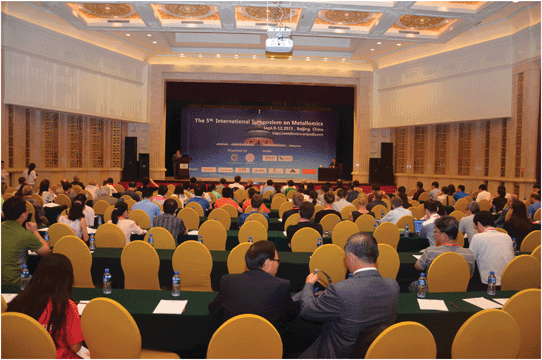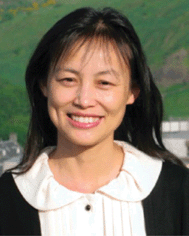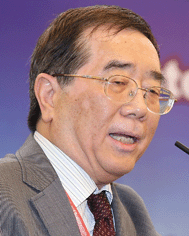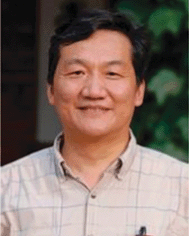Fifth International Symposium on Metallomics 2015
Multiple authors
ISM2015 was held in Beijing, China from September 9–12, 2015. This symposium was co-hosted by Professor Zhifang Chai (Chair) from the Institute of High Energy Physics, Chinese Academy of Sciences and Professor Xinrong Zhang (Co-Chair) from Tsinghua University. Over 200 participants from 18 countries/regions joined this meeting. The scientific programme included six plenary lectures, 42 keynote lectures, 36 oral presentations and 63 posters. Six young researchers were awarded poster prizes sponsored by Metallomics and Analytical and Bioanalytical Chemistry.
The plenary lectures were selected to cover the wide boundaries of the field of metallomics: Professor Hiroki Haraguchi from Nagoya University, who initiated and hosted the first International Symposium on Metallomics, introduced the current status and perspective of metallomics; Professor Guibin Jiang from the Research Center for Eco-Environmental Sciences, Chinese Academy of Sciences, introduced metallomics studies on mercury and initiated a new branch of metallomics: environmental metallomics;1 Professor Ryszard Lobinski from Centre National de la Recherche Scientifique (CNRS) presented the recent advances and development trends in the metallomics toolbox; Professor Gary Hieftje from Indiana University displayed newly developed machines and methods for metallomics; Professor Chris Le from the University of Alberta presented a targeted metallomics study of arsenic binding to proteins; Professor Hongzhe Sun from Hong Kong University showed an integrative metallomics approach to identify metalloproteins in microbes and Professor Yuliang Zhao from the National Center for Nanoscience and Technology analyzed the interactions of nanoparticles with a biological system in vitro and in vivo, in which nanometallomics was also included.2
The invited lectures, oral presentations and posters were divided into five sessions: Metals in Biology: Function and Fate; Metals in Medicine: Diagnosis and Therapy; Geosphere–Biosphere Interactions; Nanomaterials in Biology and Analytical Methods and Instrumentation.
The opening session of the Fifth International Symposium on Metallomics 2015.
The themed issue of Metallomics on ISM2015 reflects the wide coverage of metallomics presented at the conference. Yaqin Zhao et al. systematically investigated the molecular mechanism of cerium oxide nanoparticles in protecting against neuronal cytotoxicity from amyloid peptides and copper ions, and found that cerium oxide nanoparticles reduced Aβ1–42 aggregation, protected from the neurotoxicity of ROS.3 Yunyun Li et al. investigated the proteins involved in the toxicity of mercury in the rice plant and found the proteins responsive to mercury exposure were involved in antioxidative defense, sulfur and glutathione metabolism, carbohydrate and energy metabolism, programmed cell death, and pathogen defense.4 Wenjing Zhao et al. examined the changes in angiogenic factors and their relation to the depressed capillary density in the Rhesus monkey model of myocardial ischemic infarction, and found that copper loss could suppress the expression of critical angiogenic genes regulated by HIF-1.5 Hachmoller et al. studied the elemental distribution and speciation in a liver biopsy specimen from a Wilson's disease patient using synchrotron radiation based micro-X-ray fluorescence and X-ray absorption near edge structure spectroscopy, and found a mixture of Cu+ and Cu2+ within the liver tissue.6 Asplatin demonstrates significantly higher cytotoxicity than cisplatin towards tumor cells, and almost fully overcomes the drug resistance of cisplatin-resistant cells. Qinqin Cheng et al. studied the molecular mechanism of asplatin through investigating the cellular response to this compound to understand the prominent inhibitory effect on the proliferation of cancer cells.7
We would like to express our gratitude to all authors and contributors and hope that all readers will enjoy reading this themed issue as we have.
Following the previous five successful meetings, the 6th International Symposium on Metallomics will be held in Europe in 2017, and we are looking forward to seeing you again.
Professor Chunying Chen, guest editor of this issue, is a principal investigator at CAS Key Laboratory for Biomedical Effects of Nanomaterials and Nanosafety, National Center for Nanoscience and Technology of China. Her research interests include the potential toxicity of nanoparticles, therapies for malignant tumors using theranostic nanomedicine systems and vaccine nanoadjuvants using nanomaterials, which are supported by the China MOST 973 Programs, EU-FP6 and FP7 and IAEA. She has authored/co-authored over 140 peer-reviewed papers, 4 books (including Nuclear Analytical Techniques for Metallomics and Metalloproteomics, RSC publishing in 2010, and Metallomics, Science Press in 2016) and over 10 book chapters. She is a member of the Editorial Board of Metallomics.
References
- L. Hu, B. He, G. Jiang, in Metallomics, ed. Y.-F. Li, H. Sun, C. Chen, Z. Chai, Science Press, Beijing, 2016 Search PubMed.
- Y.-F. Li, Y. Gao, Z. Chai and C. Chen, Nanometallomics: an emerging field studying the biological effects of metal-related nanomaterials, Metallomics, 2014, 6, 220–232 RSC.
- Y. Zhao, Q. Xu, W. Xu, D. Wang, J. Tan, C. Zhu and X. Tan, Probing the molecular mechanism of cerium oxide nanoparticles in protecting against the neuronal cytotoxicity of Aβ1–42 with copper ions, Metallomics, 2016 10.1039/C5MT00242G.
- Y. Li, J. Zhao, Y.-F. Li, X. Xu, B. Zhang, Y. Liu, L. Cui, B. Li, Y. Gao and Z. Chai, Comparative metalloproteomic approaches for the investigation proteins involved in the toxicity of inorganic and organic forms of mercury in rice (Oryza sativa L.) roots, Metallomics, 2016 10.1039/C5MT00264H.
- W. Zhang, X. Zhao, Y. Xiao, J. Chen, P. Han, J. Zhang, H. Fu and Y. J. Kang, The association of depressed angiogenic factors with reduced capillary density in the Rhesus monkey model of myocardial ischemia, Metallomics, 2016 10.1039/C5MT00332F.
- O. Hachmoller, A. G. Buzanich, M. Aichler, M. Radtke, D. Dietrich, K. Schwamborn, L. Lutz, M. Werner, M. Sperling, A. Walch and U. Karst, Elemental bioimaging and speciation analysis for the investigation of Wilson's disease using μXRF and XANES, Metallomics, 2016 10.1039/C6MT00001K.
- Q. Cheng, H. Shi, H. Wang, J. Wang and Y. Liu, Asplatin enhances drug efficacy by altering the cellular response, Metallomics, 2016 10.1039/C6MT00066E.
| This journal is © The Royal Society of Chemistry 2016 |




